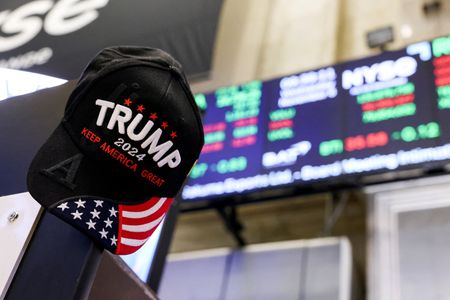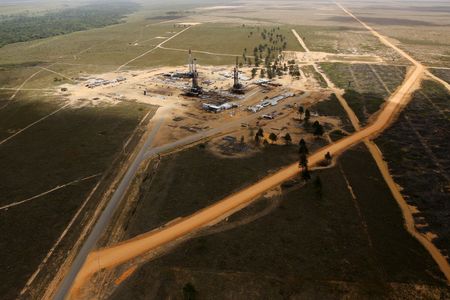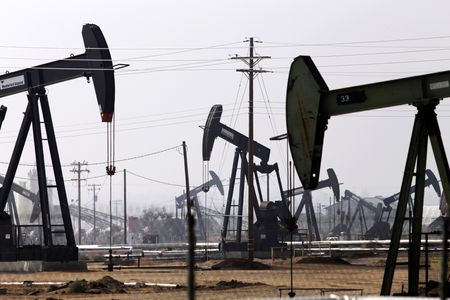By Georgina McCartney
HOUSTON (Reuters) -U.S. oil prices slipped on Tuesday on tariff drama between Washington and Beijing, then pared losses after an official said President Donald Trump plans to restore his “maximum pressure” campaign on Iran in a bid to drive down Iranian oil exports to zero.
The U.S. official told Reuters Trump’s directive orders the Treasury secretary to impose “maximum economic pressure” on Iran, including sanctions and enforcement mechanisms.
U.S. West Texas Intermediate (WTI) crude was trading down 19 cents, or 0.26%, at $72.97 a barrel by 1:47 p.m. EST (1847 GMT).
Oil came under pressure early as new 10% U.S. tariffs on Chinese imports took effect on Tuesday, spurring retaliatory tariffs announced by Beijing. At its session low U.S. crude was down more than 3%, the lowest since late December.
Global benchmark Brent crude futures rose 42 cents, or 0.55%, to $76.38.
Trump had driven Iran’s oil exports to near-zero during part of his first term after re-imposing sanctions. They rose under former President Joe Biden’s tenure as Iran succeeded in evading sanctions.
“The reason why oil was down near the lower end of the trading range was the China retaliation, and it went back up because of the “maximum pressure” on Iran,” said Phil Flynn, analyst at Price Futures Group.
Iranian crude exports shot to the highest level in years in 2024 as the country found ways to sidestep punitive sanctions.
WASHINGTON-BEIJING TARIFF DRAMA
Traders are eyeing efforts underway to schedule a call between Trump and Chinese President Xi Jinping.
It was unclear when the two would actually speak.
Earlier, Trump trade adviser Peter Navarro said the two leaders would speak, suggesting to investors there was scope for China to receive a temporary reprieve as Trump granted to Mexico and Canada on Monday.
White House spokeswoman Karoline Leavitt had said a call between the heads of the world’s two largest economies “will happen very soon.” The Wall Street Journal cited a U.S. official as saying Trump and Xi would not speak on Tuesday.
“Oil was down on the China retaliation, I think it’s the expected Trump-Xi call bringing us back up, and we kind of know how those go now, in terms of walking this all back,” said John Kilduff, a partner at Again Capital in New York.
On Monday, Trump suspended his threat of steep tariffs on Mexico and Canada, agreeing to a 30-day pause in return for concessions on border and crime enforcement.
Ongoing trade tensions between the U.S. and China may dampen demand for oil, further pressuring prices.
“The tit-for-tat measures out from China may not stop at just the 10% tariffs on crude oil from the U.S., which can also see a deliberate attempt to weaken the yuan if the U.S. fires back with more tariffs on China exports to the U.S.,” said Kelvin Wong, senior market analyst at OANDA.
“Overall such actions are likely to give rise to a stronger U.S. dollar that in turn weakens … oil prices given that OPEC+ members are still on track to increase oil supply gradually from April.”
China’s 2024 crude oil imports from the U.S. accounted for 1.7% of its total crude imports, customs data shows.
“The Chinese are smart targeting crude oil and liquefied natural gas (LNG), because that’s effectively going to knock them out of the U.S. market as you’re adding $5-7 a barrel, depending on pricing and that’s just not competitive,” said Again Capital’s Kilduff.
Meanwhile, investors are awaiting U.S. oil stockpile data from the American Petroleum Institute.
(Reporting by Georgina McCartney in Houston, Katya Golubkova in Tokyo and Trixie Yap in Singapore and Arunima Kumar in Bengaluru; Additional reporting by Florence Tan and Siyi LiuEditing by David Goodman, Kirsten Donovan and David Gregorio)










